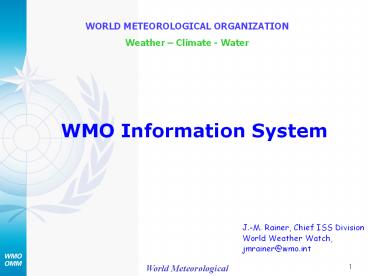WMO Information System - PowerPoint PPT Presentation
1 / 15
Title:
WMO Information System
Description:
WORLD METEOROLOGICAL ORGANIZATION Weather Climate - Water WMO Information System J.-M. Rainer, Chief ISS Division World Weather Watch, jmrainer_at_wmo.int – PowerPoint PPT presentation
Number of Views:117
Avg rating:3.0/5.0
Title: WMO Information System
1
WMO Information System
WORLD METEOROLOGICAL ORGANIZATION Weather
Climate - Water
J.-M. Rainer, Chief ISS Division World Weather
Watch, jmrainer_at_wmo.int
2
WIS brings new features and opportunities
- Common information exchange standards, functions
and services for all WMO programmes - Inter-disciplinary discovery, retrieval and
exchange of information in real and non-real time
- On-line catalogues using metadata based on ISO
19100 (geographic information standard) - Industry standards and off-the-shelf hardware and
software systems to ensure cost-effectiveness and
inter-operability
3
Structure of WIS
- Functional centres
- National Centres (NC)
- Global Information System Centres (GISC)
- Data Collection and Production Centres (DCPC)
- and
- Data communication networks
- WIS concerns only information exchange and data
management functions
4
National Centre (NC)
- Provides information collected/generated in the
country to a GISC or DCPC - Serves as portal for national users and/or
administrates their access to WIS - Several NCs in a country are possible (not just
the NMC)
Data Collection and Production Centre (DCPC)
- Provides the programme-related data products
for international exchange - Supports information Push and Pull mechanisms
- Generates, maintains, makes accessible and
provides to GISCs metadata catalogues of its data
products
5
Global Information System Centre (GISC)
- Receives information from NCs and DCPCs
- Exchanges information (data and metadata) with
other GISCs - Disseminates, within its area of responsibility,
the entire set of WMO data and products for
routine global exchange - Supports information Pull mechanisms
- Generates, maintains and makes accessible
metadata catalogues of all data and products for
global echange - Ensures around-the-clock, reliable and secure
operations
6
European Virtual GISC Project
7
WIS, a key issue interoperability
- Interoperability enables the discovery, the
retrieval and the usage of the data - It needs the development and the implementation
of relevant Metadata standards - Development of a WMO Metadata Profile of the ISO
191xx series for geographic information - Step 1 development of the WMO Metadata Core
Profile of ISO 19115 for data discovery - Step 2 Use of the ISO 191xx series for the
access and use of the data
8
WIS Implementation
- Major functions needed
- Metadata catalogues
- Internet portal
- Data acquisition and discovery services
- Data distribution service push and pull
- Monitoring
- Operational aspects like data synchronisation,
back-up, administrative issues, etc. - To that end, work is being already undertaken by
pilot projects in the different WMO Programmes
9
WIS DATA-COMMUNICATIONS IMPLEMENTATION(for
weather, water, climate and related data and
products)
DAR
Essentially through the Internet(HTTP, FTP, VPN)
Essentially through telecom. with guaranteed
quality of service, e.g. leased circuits,
dedicated data com network services, sat.-based
systems, ..
WIS
Essentially through satellite based data
distribution systems, e.g. DVB-S
IGDDS
GTS
WIS/GTS for time and operation-critical data
products WIS/IGDDS for space-based data
products WIS/DAR data discovery, access and
retrieval Data push routine distribution of
data products Data pull access to and
retrieval of data products
10
WIS Implementation plan initial phase
- Reference implementation WMO Core metadata
- Integration of metadata structures into pilot
GISCs and DCPCs - Internet portal
- Basic data acquisition, discovery and push-pull
services - RA VI VGISC project as a GISC prototype
- DCPCs prototypes including the ECMWF and
EUMETSAT DCPC projects associated with the VGISC
project - NCAR DCPC prototype
- DCPC prototype for JCOMM related data
- Technical Conference on WIS (Korea, 6-8 November
2006) preceding CBS-Ext.06
11
Relevance to WCRP(input for WOAP discussion)
- WCRP and GCOS participate in internal WMO
coordination group (Satyan, Sommeria) - One proposed WCRP WIS related pilot project
THORPEX/WCRP Coordinated Observing, Modelling and
Forecasting of Tropical Convection and Monsoons - CEOP a possible candidate pilot project
(S.Williams has participated to an earlier
meeting) - Participation welcome in CBS Technical Conference
on WIS, 6-8 November 2006 in Seoul
12
Thank You
13
GTS dissemination of Tsunami Watch Information
(TWI) for the Indian Oceanissued by Honolulu
(PTWC) and Tokyo (JMA)
- Also including via GTS-related satellite data
distribution systems - RETIM-Africa, EUMETCast (West IO), CMA PCVSAT
(N-E IO), ISCS and EMWIN (East IO)
14
Several on-going pilot projects test and evaluate
functional concepts and architectures
- The WMO Core Metadata Standard
- The Virtual (distributed) Global Information
System Centre (VGISC) in RA VI, including the
European SIMDAT project - RA II V Virtual Private Network (VPN) project
- The EUMETNET UNIDART project (Portal)
- The JCOMM End-to-End Data Management Project
(E2EDM) prototype - The DMAC subsystem project for IOOS
- The Roshydromet CliWare project
- The WAMIS project for agro-meteorological
information (CAgM) - and also the Earth System GRID, the Community
Data Portal, the Earth Sciences Portal - Early application of WIS to the THORPEX
Interactive Grand Ensemble (TIGGE)
15
WIS
Information exchange
common procedures real-time and non-real time
Information management
a few standard data formats coordinated metadata
and catalogues
International Organizations (IAEA, CTBTO, UNEP,
FAO.. )
World Radiation Centre Regional Instrument Centres
5 GAW World Data Centres GCOS Data Centres Global
Run-off Data Centre
IRI and other climate research institutes Universi
ties Regional Climate Centres
Commercial Service Providers
WMO World Data Centres
internet
Real-time push































